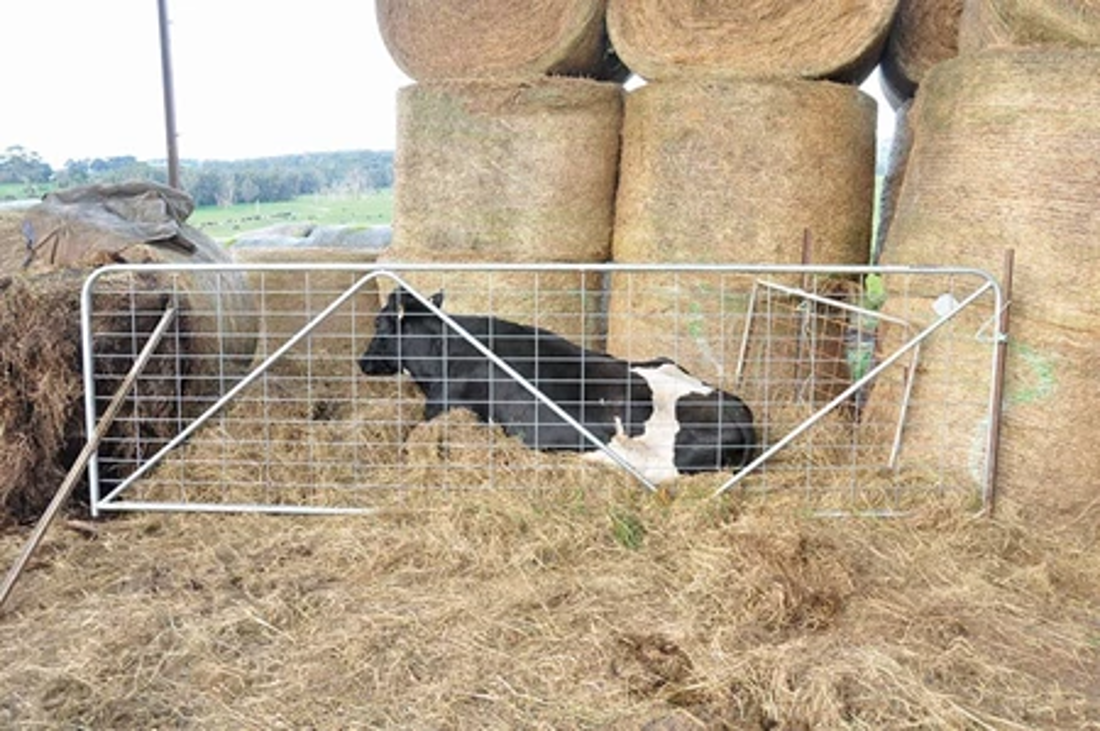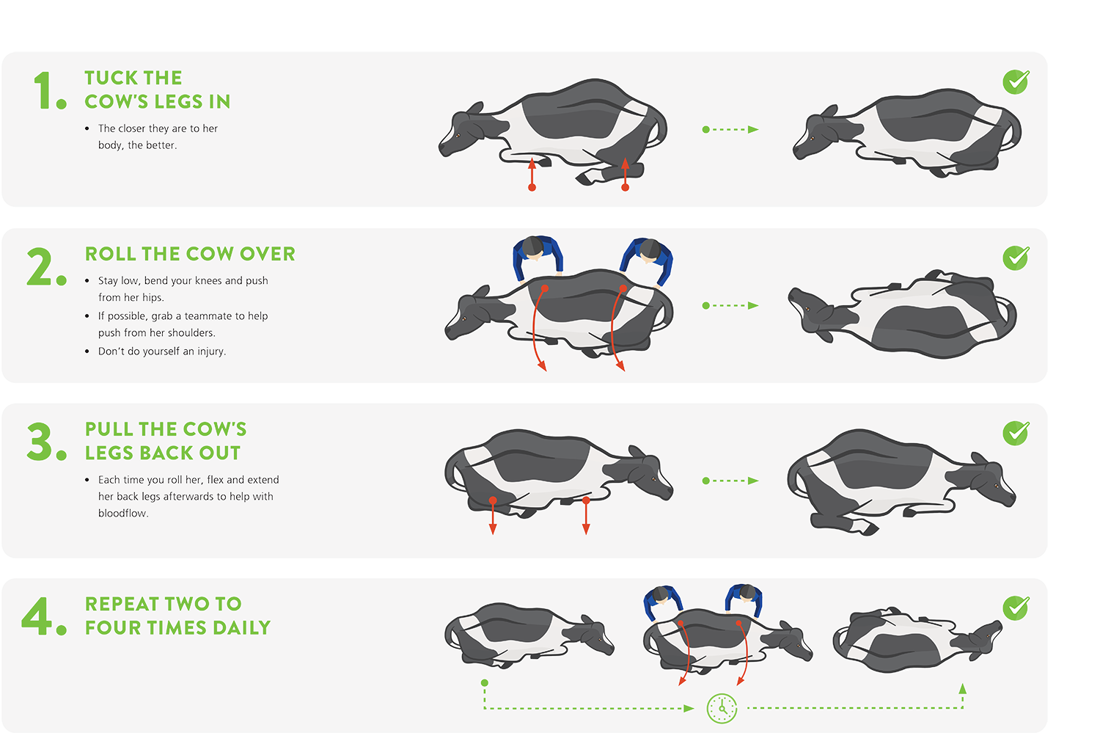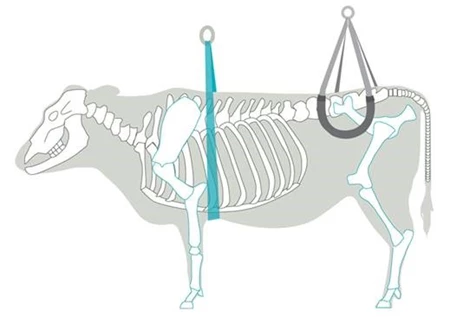Down Cows
4 min read
Managing down cows is crucial for dairy farmers. When a cow is down, it's important to promptly diagnose the cause, decide on a treatment, and follow a management plan. This page provides guidelines on preventing, diagnosing, and treating down cows, covering everything from mineral supplementation to creating a dedicated nursing area. It gives practical advice on how to roll or lift a cow, when to consider euthanasia, and methods of transportation for a down cow. Understanding and implementing these strategies can ensure the wellbeing of your herd and increase productivity.
Getting a down cow back on her feet and returned to the herd as quickly as possible is rewarding for you and the best outcome for the cow.
Down cows should be a priority no matter what else is happening on-farm. Cows that are down may be sore, uncomfortable, and stressed. It’s our responsibility to make quick decisions to ensure they receive the correct care and are as comfortable as possible.
By correctly diagnosing, quickly treating, and nursing down cows at a high standard, you can maximise their chance of recovery and reduce stress for everyone during a busy calving season.
Many of the factors that cause cows to go down are preventable. Minimise your chance of down cows by using appropriate bull selection, careful mineral supplementation, good springer management, and accurate body condition scoring to ensure cows are not too fat or too thin at calving.

Creating a dedicated nursing area can help increase your down cows’ chances of recovery
Photo credit: Dairy Australia
There are three key steps to ensure better outcomes for you and your down cows:
There are many causes of down cows, including:
Early diagnosis and treatment will maximise the cow’s chances of a quick recovery. In some cases, a cow may recover on the same day. If it’s looking like it will take longer, she should be moved to a suitable, dedicated nursing area.
The best place for a down cow is under a roof or well sheltered area. But if you can’t provide a dedicated down cow area, some easy ways to care for cows in the paddock include using cow covers or putting out a few hay bales to provide shelter from the weather.
If a down cow is non-responsive or very ill, a quick decision should be made on whether treatment is viable.
Research shows high-quality care significantly increases a down cow’s chances of recovery from their initial cause of going down and prevents further complications. However, research also shows that down cow care has little benefit unless we implement ALL the factors below. So, there’s no point taking shortcuts.
Think about what you want when you’re sick - somewhere comfortable to lie that’s dry and warm, some palatable food, and lots of fresh water. For cows, it’s pretty much the same.
The requirements of nursing a down cow include:
If the cow is still down after 24 hours, a re-assessment should be made of whether it is worth continuing treatment. However, some cows, with careful care, can take a week or longer to recover.
Cows should never be left in pain or distress. And if a down cow can’t be nursed at a high standard of care, it is better to humanely euthanise her as her chances of recovery will be low. More information on humane slaughter.
A cow should only be lifted if it is highly likely she will be able to bear her own weight. Lifting cows before they’re ready to stand can do more harm than good.
The wings of the pelvis, where hip lifters are attached, are not designed to bear the cow’s weight. Cows that can’t hold their own weight are at risk of skin, muscle, and bone damage during lifting.
Assist the cow to stand if she:
If in doubt, roll her instead of lifting- it takes less time and is less risky to the cow.
It is important to note which leg the cow is sitting on each time you check her. Sitting on the same side all day means one back leg will take all the pressure from her body weight, leading to nerve and muscle damage.
If she can’t swap sides by herself, she needs to be regularly rolled onto her other side.

How to roll a down cow
Be sure to thoroughly check the cow for dislocations or broken bones before using hip lifters. They should only be used to assist a cow into a standing position, not to suspend a cow that is unable to stand. All four limbs should stay in contact with the ground during lifting.
A breast strap under the brisket in conjunction with hip clamps is good practice as it helps the cow up onto her front legs as her hips are raised. The additional support also minimises discomfort for the cow and provides some additional restraint, making the process safer for you and the cow.
Using a full sling to stand a cow up is not recommended as the pressure on the cow's abdomen causes the muscles in the hind leg to relax.
 Using a breast strap along with hip clamps is good practice.
Using a breast strap along with hip clamps is good practice.
Watch the animation below on correct use of hip lifters.
Follow this process to ensure you’re doing everything possible to minimise pain and discomfort for the cow and make lifting safe and stress-free for you:
Do not leave the cow unattended without removing the strap and clamp. If the cow cannot stand on her own, return her to the ground slowly and try again later. If she still cannot stand on her own 24 hours after going down, seek veterinary advice.
Watch the video below to see how to correctly use hip clamps to lift a down cow.
Hip clamps should not be used to move cows. If you need to move a cow, use a transport tray, tandem trailer or front-end loader bucket. Regardless of the method of transport, be sure to restrain the cow to prevent any additional harm, pain or distress.
In this Talking Dairy episode, host Jac McGowan and Mitch Cooper, veterinarian and DairyNZ’s Senior Technical and Policy Advisor, discuss how to prevent and manage down cows during calving season. Get practical tips on how to recognise early signs, treatment and care .
Now’s the perfect time to check in, plan, and set up for a strong season. We’ve pulled together smart tips and tools to help you stay ahead all winter long.
Whether you prefer to read, listen, or download handy guides, we’ve got you covered with trusted tools to support your journey every step of the way.